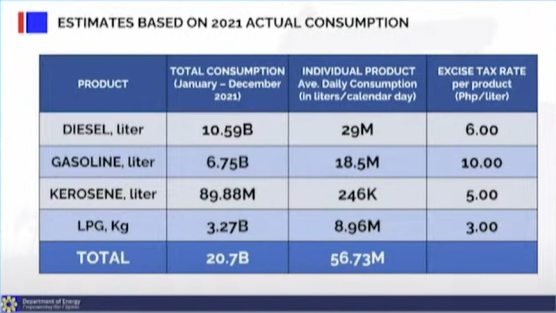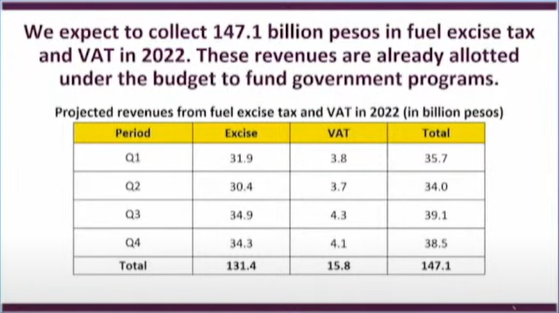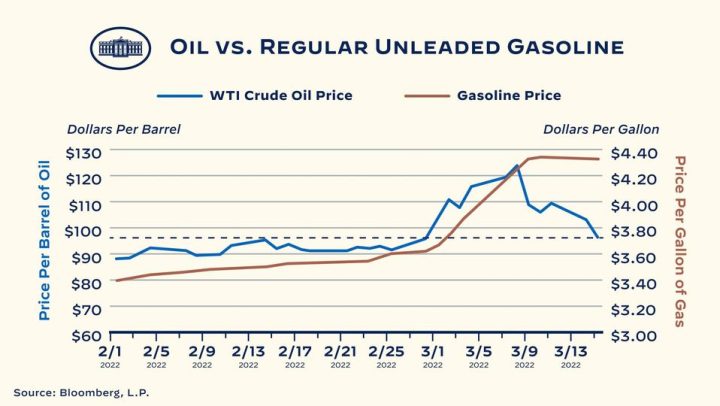An adage goes, “In this world nothing can be said to be certain, except death and taxes.” For that matter, excise tax is a form of indirect tax, a kind of taxation that is more difficult to evade than direct taxes such as income tax or property tax. In principle, therefore, virtually everyone pays their share of taxes through the mix of direct and indirect taxes. One of the more relevant excise taxes in public consciousness today would be the fuel excise tax, which is imposed over different petroleum products, owing to rising oil prices in the Philippines and overseas.

“There is no stopping the executive, specifically the Department of Finance and the Bureau of Internal Revenue, from suspending the collection of excise taxes on petroleum products, if they really want to mitigate the impact of high oil prices on the cost of goods and living expenses of the ordinary Filipino,” said Senator Franklin Drilon, who advocates for a more liberal interpretation of the Tax Reform for Acceleration and Inclusion (TRAIN) Act governing the fuel excise tax, “Clearly, the spirit of the law is to give the government elbow room to address situations where the price of crude oil in the world market exceeds USD 80PHP 4,695INR 6,780EUR 76CNY 582.”
To be fair, almost every nation in the Organization for Economic Cooperation and Development (OECD) have implemented their own version of fuel taxes. Thus, the Philippines can assure itself that it is not alone on having this concept. However, why would the Filipino government choose to ramp up subsidies instead of suspending fuel excise taxes altogether, despite a rising call for suspension even among national candidates for the 2022 election?

“We realized that this is not enough but this is what we can afford as of this time,” said Department of Finance Secretary Carlos “Sonny” Dominguez in their recommendations to President Rodrigo Duterte last March 16, “And to make sure that our finances, going forward and especially for the next administration are still going to be healthy, this I believe is what we can afford.”
Indeed, whereas more than PHP 147USD 3INR 212EUR 2CNY 18 billion is expected to be earned from fuel excise tax and value added tax (VAT) for 2022, subsidies will cost lower than the projected income: PHP 33.1USD 0.56INR 48EUR 0.54CNY 4 billion for a 200-peso unconditional cash transfer (UCT) dedicated to the lower 50 percent of 4Ps beneficiaries, PHP 5USD 0.09INR 7EUR 0.08CNY 0.62 billion for fuel subsidies to public transportation, and PHP 600USD 10INR 867EUR 10CNY 74 million for farmers.
Taking into consideration the overall fiscal health of the Philippines, which revenue effort was equivalent to 15.6 percent of the gross domestic product (GDP) from 2017 to 2021, there is a sense of urgency in tapping revenue generation and mobilization policies as possible during these dire times. DOF added that it would have been as high as 16.2 percent if there was no pandemic. Evidently, revenues in general were lower than pre-pandemic projections, contributing to the record high PHP 12USD 0.20INR 17EUR 0.19CNY 1 trillion in debt stock for the Philippines as of January 2022.

This balancing act in hopes to reduce inequality across socioeconomic sectors during this time of crisis, however, appears to have less popular appeal and for various reasons. The World Bank, for instance, cited the need for government to tap digital services in order to increase the efficiency of cash assistance rollout.
“The Philippines’ experience in implementing the SAP in response to the COVID-19 pandemic highlights the pressing need for financial inclusion, especially among the poor. Beneficiaries of the existing social assistance program Pantawid Pamilyang Pilipino Program (Pantawid, or 4Ps) received their first SAP payment on time as a top-up to their regular grants. However, the non-4Ps beneficiaries had to go through paper-based registration and manual payments, which resulted in duplication of beneficiaries and significant delay in payment delivery,” the report authored by Yasuhiro Kawasoe said.
Such issues are not confined only in institutionalized programs, but also in stopgap measures like the fuel subsidy.
“Maybe the government would no longer punish us and we only wish for them to release this kind of assistance already, since prices of all oil products have been increasing,” said Modesto Floranda, national president of Pagkakaisa ng mga Samahan ng mga Tsuper at Operator Nationwide (Piston), “When you say ayuda (aid), it should not [take] weeks or months before [that aid is released].”
For someone who needs relief and additional money now, the promise of future aid seems too distant for comfort.

Those in government, however, sees the potential effects of suspension from another perspective: the immediate relief expected from removing the fuel excise tax are likely to benefit the wealthier segments of society. The DOF argument rests on data indicating that the top 10 percent of Filipino households constitute around 49 percent of the nation’s total fuel consumption. At this juncture, the logic may not be far off, contrary to popular belief.
A 2018 study by the Philippine Institute for Development Studies (PIDS) shows that 72 percent of economically “rich” families own cars, compared to less than 1 percent for economically “poor” families. The average monthly income of “rich” families was placed at PHP 195,000USD 3,323INR 281,697EUR 3,165CNY 24,200, while that of “poor” families at PHP 9,900USD 169INR 14,302EUR 161CNY 1,229, a level below the mandated minimum wage in the Philippines. Consider the disparity in purchasing power, and in extension, fuel consumption. What may be missing in this equation at this point would probably be the middle class – a diverse socioeconomic group with average monthly incomes ranging between PHP 25,200USD 429INR 36,404EUR 409CNY 3,127 and PHP 62,100USD 1,058INR 89,710EUR 1,008CNY 7,707.
Although the economically wealthy might be more likely to purchase cars and to travel via private transport, the same study shows that most of the cars owned in the Philippines are with the middle class: 72 percent. A combination of factors, probably including flexible financing options and the state of public transport especially during the pandemic, helped accelerate this. Car sales in 2021 was 20 percent higher than that in 2020.
Living just above the threshold to be considered economically poor, yet deprived of the financial sufficiency experienced by the economically rich, the middle class are caught in a brewing storm where they could expect the least possible relief because they neither qualify for tax incentives which the rich are more likely to avail, nor for cash subsidies which the poor are more likely to receive. A sweeping suspension, however, implies that their benefits would be just as proportional. Remember that the fuel excise tax is fixed after reaching its full implementation in 2020. The only way government would be raising more income from rising prices would be from the VAT.

Of the PHP 147USD 3INR 212EUR 2CNY 18 billion expected, however, only PHP 15.8USD 0.27INR 23EUR 0.26CNY 2 billion would come from VAT. Depending on how global oil prices would hold for the rest of the year, the fuel VAT could increase between PHP 20.3USD 0.35INR 29EUR 0.33CNY 3 billion (at USD 100PHP 5,869INR 8,475EUR 95CNY 728 per barrel) to PHP 37.5USD 0.64INR 54EUR 0.61CNY 5 billion (at USD 130PHP 7,629INR 11,017EUR 124CNY 946 per barrel). Such high-level projections, however, may have to wait.
The price of Dubai crude, the basis for Filipino policies, have decreased from a peak of USD 122PHP 7,160INR 10,339EUR 116CNY 888 per barrel on March 8 to USD 108PHP 6,338INR 9,153EUR 103CNY 786 per barrel on March 17. For comparison, the price was just USD 73PHP 4,284INR 6,187EUR 70CNY 531 per barrel on December 31, 2021.
“Dalawang bagay po ang nakapagpababa: ang isa po is the lockdown in China because of COVID and ang projection po ng lower demand for oil by China; and ito pong dalawang araw na tuloy-tuloy na pag-uusap between Russia and Ukraine, medyo na-temper din po ‘yung demand for oil,” explained Department of Energy (DOE) Secretary Alfonso Cusi, who earlier raised the possibility of partial suspension of excise taxes for low octane fuels.

The International Energy Agency (IEA) already cut its oil demand forecast for 2022, and oil producers seem unlikely to increase their production if it meant using their spare capacity. As it stands, no one country could hope to cover losses from Russian production, but worldwide demand appears to be adjusting to the “supply shock.” The question that follows would be how fast shall this adjustment be, and how drastic will the actual reduction be for 2022.
This paradoxical trend, however, does not seem to be confined in the Philippines. Take for example the United States, a petroleum prosumer (producer and consumer). President Joe Biden, in observing how the local American market had not yet kept up in pace with decreasing global oil prices as of March 16, 2022, talked about how “oil and gas companies shouldn’t pad their profits.”
Compared to Dubai crude, the decrease with WTI crude is even more pronounced: from USD 123PHP 7,218INR 10,424EUR 117CNY 895 per barrel on March 8 to USD 95PHP 5,575INR 8,051EUR 90CNY 691 on March 16. A slight uptick to USD 104PHP 6,103INR 8,814EUR 99CNY 757 per barrel as of March 18, which occurred as the conflict in Ukraine continues, still makes WTI crude a tad cheaper than the latest price available for Dubai crude.
Also, the fuel excise taxes in the United States are relatively smaller than in the Philippines: USD 0.18PHP 11INR 15EUR 0.17CNY 1 per gallon (approximately PHP 10USD 0.17INR 14EUR 0.16CNY 1) for gasoline and USD 0.24PHP 14INR 20EUR 0.23CNY 2 per gallon (approximately PHP 13USD 0.22INR 19EUR 0.21CNY 2) for diesel. A US gallon is equivalent to 3.785 liters. Of course, this refers only to federal taxes. State taxes would differ.

At any rate, some would like to explain that delays in the supply chain may have contributed to this phenomenon in the United States. Then again, the DOE in the Philippines already projects a decrease in oil prices as early as the following week. Would have not it been about time for the United States to experience a similar trend?
Notably, when Dubai crude reached USD 105PHP 6,162INR 8,899EUR 100CNY 764 in May 2014, believed to be an effect of the earlier conflict between Russia and Ukraine (particularly on the Crimea), DOE reported that common gasoline prices were at PHP 54USD 0.92INR 78EUR 0.88CNY 7 per liter, while common diesel prices were at PHP 43.95USD 0.75INR 63EUR 0.71CNY 5 per liter. This would nearly be half of the common prices observed by DOE as of March 17, 2022. That is, PHP 76.65USD 1INR 111EUR 1CNY 10 per liter for gasoline, and PHP 75.45USD 1INR 109EUR 1CNY 9 per liter for diesel.
Even if one were to deduct the fuel excise taxes, PHP 10USD 0.17INR 14EUR 0.16CNY 1 for gasoline and PHP 6USD 0.10INR 9EUR 0.10CNY 0.74 for diesel, the common prices for gasoline and diesel in the Philippines would have still been higher than it was in 2014, when global prices, or at least Dubai crude, were nearly in the same level – a difference of USD 3PHP 176INR 254EUR 3CNY 22 per barrel between May 2014 and March 2022.
Where lies the disconnect between global and local petroleum markets? If not the TRAIN Act, would a reexamination and amendment of the Downstream Oil Industry Deregulation Act of 1998 be the solution, as recommended by the DOE? If deregulation is the problem, is reregulation the answer?
Other proposals, such as the creation of a Strategic Petroleum Reserve (SPR), as well as the restoration of the Oil Price Stabilization Fund (OPSF), are also on the table. The SPR, at least, is also being taken into mind by the DOE. Memorandum Order 2019-11-0001 has already provided for the conduct of a feasibility study on having a National Strategic Petroleum Reserve equivalent to 90 days of the nation’s domestic oil requirements. Considering the limitations of the article, however, they may have to be discussed in another time.
In retrospect, would have there been a set of policies available in the context of the Philippines which could optimize benefits across all sectors of society? Is the aim equality or equity? Or perhaps another goal: fairness and justice?

YugaTech.com is the largest and longest-running technology site in the Philippines. Originally established in October 2002, the site was transformed into a full-fledged technology platform in 2005.
How to transfer, withdraw money from PayPal to GCash
Prices of Starlink satellite in the Philippines
Install Google GBox to Huawei smartphones
Pag-IBIG MP2 online application
How to check PhilHealth contributions online
How to find your SIM card serial number
Globe, PLDT, Converge, Sky: Unli fiber internet plans compared
10 biggest games in the Google Play Store
LTO periodic medical exam for 10-year licenses
Netflix codes to unlock hidden TV shows, movies
Apple, Asus, Cherry Mobile, Huawei, LG, Nokia, Oppo, Samsung, Sony, Vivo, Xiaomi, Lenovo, Infinix Mobile, Pocophone, Honor, iPhone, OnePlus, Tecno, Realme, HTC, Gionee, Kata, IQ00, Redmi, Razer, CloudFone, Motorola, Panasonic, TCL, Wiko
Best Android smartphones between PHP 20,000 - 25,000
Smartphones under PHP 10,000 in the Philippines
Smartphones under PHP 12K Philippines
Best smartphones for kids under PHP 7,000
Smartphones under PHP 15,000 in the Philippines
Best Android smartphones between PHP 15,000 - 20,000
Smartphones under PHP 20,000 in the Philippines
Most affordable 5G phones in the Philippines under PHP 20K
5G smartphones in the Philippines under PHP 16K
Smartphone pricelist Philippines 2024
Smartphone pricelist Philippines 2023
Smartphone pricelist Philippines 2022
Smartphone pricelist Philippines 2021
Smartphone pricelist Philippines 2020
Paul says:
Meanwhile I’m just waiting for someone in congress to file a bill for some kind of subsidy or tax credit for EV cars.
It’s timely too since the next admin whoever wins seem like they will be investing on renewable and/or nuclear energy.